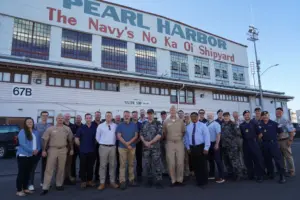
Uniformed and civilian submarine maintenance experts from Australia, the U.K and U.S. reported to Pearl Harbor this week to start learning what maintenance skills will be required to establish the allied rotational submarine force in Australia by 2027. Last month, Vice Adm. Bill Galinis, commander of Naval Sea Systems Command, named Pearl Harbor Naval Shipyard and Intermediate Maintenance Facility (PHNSY & IMF) as the naval supervising authority and lead maintenance activity for the future Submarine Rotational Force-West (SRF-W) (Defense Daily,…

 By
By 











